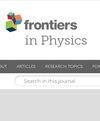设计具有准正常模式的电磁谐振器
IF 1.9
3区 物理与天体物理
Q2 PHYSICS, MULTIDISCIPLINARY
引用次数: 0
摘要
微谐振器和纳米谐振器能够在小体积内实现长时间的光捕获,在现代光子学中发挥着至关重要的作用。这些谐振器的光学响应由其基本共振决定,即所谓的准正常模式(QNMs)。在过去的十年中,QNMs 的电磁理论得到了长足的发展,现在已经达到了一定的成熟度,可以可靠地应用于众多当代电磁问题。在这篇综述中,我们将探讨 QNM 理论在设计和理解微型和纳米谐振器方面的最新应用。我们强调了 QNM 为何能在涉及模式杂化和扰动的情况下提供深刻的物理洞察力并提高计算效率。本文章由计算机程序翻译,如有差异,请以英文原文为准。
Designing electromagnetic resonators with quasinormal modes
Micro- and nanoresonators, which enable light trapping in small volumes for extended durations, play a crucial role in modern photonics. The optical response of these resonators is determined by their fundamental resonances, known as quasinormal modes (QNMs). Over the past decade, the electromagnetic theory of QNMs has undergone significant development and has now reached a level of maturity that allows its reliable application to numerous contemporary electromagnetic problems. In this review, we explore recent applications of QNM theory for designing and understanding micro and nanoresonators. We highlight why QNMs provide deep physical insights and enhance computational efficiency in scenarios involving mode hybridization and perturbation.
求助全文
通过发布文献求助,成功后即可免费获取论文全文。
去求助
来源期刊

Frontiers in Physics
Mathematics-Mathematical Physics
CiteScore
4.50
自引率
6.50%
发文量
1215
审稿时长
12 weeks
期刊介绍:
Frontiers in Physics publishes rigorously peer-reviewed research across the entire field, from experimental, to computational and theoretical physics. This multidisciplinary open-access journal is at the forefront of disseminating and communicating scientific knowledge and impactful discoveries to researchers, academics, engineers and the public worldwide.
 求助内容:
求助内容: 应助结果提醒方式:
应助结果提醒方式:


